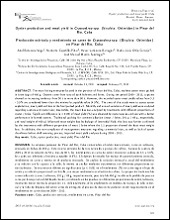Oyster production and meat yield in Crassostrea spp. (bivalvia: Ostreidae) in Pinar del Rio, Cuba
Producción ostrícola y rendimiento en carne de Crassostrea spp. (Bivalvia: Ostreidae) en Pinar del Río, Cuba
Autor
Abel de Jesús Betanzos Vega
NORBERTO CAPETILLO PIÑAR
Hever Latisnére Barragán
NADIA LIVIA ORTIZ CORNEJO
JOSE MANUEL MAZON SUASTEGUI
Metadatos
Mostrar el registro completo del ítemResumen
"The main fishing enterprise located in the province of Pinar del Río, Cuba, markets oyster meat packed in brine bags of 460 g. Oysters come from natural bank fisheries and farms. During the period 2009 - 2013, captures showed an increasing tendency from 50 t to more than 80 t. However, the recorded oyster meat yields values from 3.3 - 3.9% are considered lower than the minimal acceptable value (4.9%). The aims of this study were to assess oyster exploitation, meat yield and loss in the final packed product. Monthly and annual variations of meat yield were analyzed regarding capture and oyster size; meanwhile, the meat loss was analyzed by treatments with different proportions of oyster / brine. Significant difference (p < 0.05) of meat yield (%) was observed by oyster species and size with a better performance in farmed oysters. Traditional packing for commercialization (meat / brine, 391 g / 69 g, respectively, and total weight of 460 g) influenced meat weight loss by leakage of interstitial fluid; this loss was further confirmed by the treatments with different proportions of meat / brine where the 1:1 proportion showed the least meat weight loss. In addition, the non-compliance of management measures regarding commercial size, as well as lack of oyster cleanliness before shell removing process, impacted meat yield analyses during 2009 - 2013." "La empresa pesquera de Pinar del Río, Cuba comercializa el ostión desconchado, carne en salmuera, envasada en bolsas de 460 g. Este recurso proviene de bancos naturales y granjas de cultivo. Aunque la captura de 2009 a 2013 incrementó de 50 a más de 80 t, los rendimientos en carne de ostión mostraron valores de 3.3 a 3.9%, los cuales son inferiores al mínimo aceptable (4.9%). El objetivo de estudio fue evaluar el aprovechamiento ostrícola, rendimiento en carne y merma en el producto envasado. Se analizó la variación mensual y anual del rendimiento y su relación con la captura y la talla; la merma se analizó mediante tratamientos con diferentes proporciones ostión/salmuera. Se encontraron diferencias significativas (p < 0.05) en el rendimiento (%) en carne según el tipo de ostión y su relación proporcional con la talla, con mayor rendimiento en el ostión de cultivo. La proporción tradicional de comercialización (carne / salmuera, 391 g / 69 g, respectivamente; peso total de 460 g) incidió en la pérdida de peso en carne por drenaje natural del líquido tisular, corroborado en las pruebas con diferentes proporciones de ostión/salmuera, mostrando menor merma la proporción 1:1. Adicionalmente, el incumplimiento en medidas de manejo, la talla comercial y la falta de limpieza del ostión antes de entregarlo al proceso de desconche pudieron incidir negativamente en el rendimiento en carne durante 2009 - 2013."
Colecciones
Ítems relacionados
Mostrando ítems relacionados por Título, autor o materia.
-
PROMOCIÓN DEL PERIFITON PARA EL CULTIVO DE CAMARÓN BLANCO: HACIA UNA ACUICULTURA ECOLÓGICA
DOMENICO VOLTOLINA LOBINA; JUAN MANUEL AUDELO NARANJO; MARIA DEL ROSARIO PACHECO MARGES -
Suelo y Erosión
YOLANDA LOURDES MAYA DELGADO


